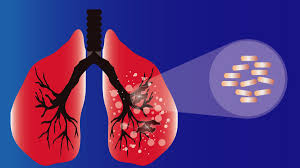Pulmonary tuberculosis is a pulmonary infectious disease caused by Mycobacterium tuberculosis. Pulmonary tuberculosis is categorized as air borne disease, a disease transmitted through air, and there are more cases of this TB compared to other TBS with the high mortality rate. Infection is transmitted through aerosol containing Mycobacterium tuberculosis. The bacteria spread by air when TB patient coughs, speaks and sneezes. The bacteria cause lung damage.
Tuberculosis (TB) is a major health problem with an estimated 10 million people having developed TB disease causing 1.3 million deaths in 2017. Indonesia was ranked third high TB burden country in 2017 with 842,000 TB cases.
Acid-fast bacilli (AFB) and culture of Mycobacterium tuberculosis from sputum samples were commonly used for TB diagnosis and monitoring. The culture of M. tuberculosis has better sensitivity and specificity than smear examination. However, the time needed to obtain culture results is around 8 weeks which cause significant delays in diagnosis and starting treatment, also monitoring treatment response. Sputum conversion can be a strong prediction and an early indication of treatment success. There were different times for sputum conversion in every patient, even though treated with the same standard regimen. Sputum conversion occurred in the 2nd month of intensive phase treatment.
One of the markers to see TB treatments’ response is Adenosine deaminase (ADA) serum. Elevated serum ADA levels in PTB patients conform to the severity of the disease, high bacterial isolation, and lung tissue damage. The examination of ADA activity is fast, affordable, and has high sensitivity and specificity to be used as a supporting diagnosis of pulmonary TB (PTB). Studies on changes in serum ADA levels in new PTB cases with smear positive tuberculosis who experienced sputum conversion is useful to monitor responses from TB treatments given.
This study uses cross-sectional observational analytic design aimed to analyze changes in serum ADA levels in new PTB cases with smear positive tuberculosis who experienced sputum conversion. Blood samples were taken from new PTB cases with sputum-positive smear along with graded results, AFB +1, +2, and +3 in Dr. Soetomo Hospital Surabaya. Serum ADA levels were analyzed using the enzymatic colorimetric method, using Erba XL 600. Results of serum ADA levels of TB patients were analyzed and compared to serum ADA levels of healthy people. We used a statistical test with SPSS 21.0 program. The result will be considered significant if there is significance value
Our study found that the highest mean value of serum ADA levels either before and after intensive phase TB treatment was among patients with AFB + 3, followed by AFB + 2, and AFB + 1. Examination of serum ADA levels showed that the mean value of serum ADA levels before treatment was higher than after receiving ATDs with (26.40 IU/L vs. 19.67 IU/L). Paired t-test results showed a significant difference in serum ADA levels before and after the intensive phase of TB treatment with P
Serum ADA levels of TB patients decreased after the intensive phase of TB treatment (19.67 IU/L) impying that the value of serum ADA levels became closer to the serum ADA levels of healthy people (10.18 IU/L). Based on the results, it can be concluded that the mean value of serum ADA levels was significantly decreased after the end of the intensive phase of TB treatment. The examination of serum ADA levels can be used to evaluate the response of PTB treatment.
Author: Dr. Soedarsono, dr., Sp.P(K)
Details of this study available at https://doi.org/10.4103/lungindia.lungindia_395_19
Soedarsono Soedarsono, Kana Wulung Arie Ichida Prinasetyo, Mayfanny Tanzilia, Jusak Nugraha. Changes of serum adenosine deaminase level in new cases of pulmonary tuberculosis before and after intensive phase treatment. Lung India. 2020;37:126-9.









